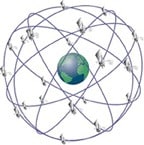How GPS provides a return on investment at your landfill immediately and for many years down the road.
By Adam Jochelson
For many landfill managers, the first reaction to GPS is hesitation or caution in the face of the unknown. Granted, it can be a little intimidating—it is rocket science after all. Plus, it’s sometimes hard to connect the dots to the future return on investment. But it doesn’t have to be that way. Progress in the field of GPS has made it so that adding this technology to a landfill can be seamless and easy while producing savings in operational costs almost immediately.
Today’s easy-to-use landfill GPS products and services lead to savings in operational costs right away in addition to long-term benefits in saved airspace. Now, using GPS at a landfill can be as easy as the touch of a button. Once the equipment is installed and calibrated, and three-dimensional models have been created, the system will practically monitor itself. Hardly any training is necessary because operators probably already know how to use it. Imagine transitioning to a more streamlined version of GPS that saves time and resources. Indeed, today’s innovative GPS products and services create benefits to a landfill’s bottom line almost immediately.
Read on for a new perspective of GPS at landfills and learn how cutting edge products and services can improve operations at landfills. Discussion of GPS implementation at landfills includes ways to overcome cost barriers, gain operator acceptance and bring landfills into the 21st century. How a particular landfill will use GPS depends on the facility’s size, but these cutting-edge technologies and techniques can help a landfill succeed, whether it processes a hundred tons each day, several thousand or more.
Successful pyramid construction requires careful grade control on every layer, bottom to top. Photo courtesy of peifferc, Creative Commons (arrows added by Adam Jochelson).
The same is true for a well-managed landfill—each lift on grade, the first time, every time.
Image courtesy of Adam Jochelson, Geoshack.
GPS 101: How It Works and Where It Is Used
Let’s start with a quick introduction to the basics of the Global Positioning System (GPS). First conceived in the early 1970s, GPS is a satellite-based system that allows users to accurately know their locations. A simplified recipe for GPS looks something like this:
- Launch a bunch of satellites into space;
- Program those satellites to broadcast their positional information by radio signal;
- Build a receiver that can detect and decode those signals;
- Use the receiver to gather multiple signals from those satellites;
- Apply some mathematical magic and … BOOM … pin-point a location.
Because accurate global positioning is a vital component of ocean-bound navigation, early versions of GPS came into military (naval) use in the 1980s. Wider use and availability to the general public began in the 1990s, when technological advances replaced bulky 50-pound receivers with significantly more portable three-pound versions. Miniaturization of the receivers continued through the next two decades and, combined with innovative application development, led to the nearly universal scope of GPS devices today. I can say with a significant degree of confidence that you probably have one in your pocket (or hand) right now.
Surveyors very quickly recognized how useful GPS technology could be in their work once the precision reached levels acceptable to their standards. Soon after that, applications sprang up in construction and mining, two industries that rely extensively on earthmoving and accurate grading of bulk materials. Progression into the landfill arena followed a natural course. After all, here was another industry with collections of heavy equipment all in one place, and a bunch of earthmoving and bulk material placement.
GPS vendors knew that landfill operators expend significant effort packing as much waste into each cubic yard of space available at those facilities. Developers devised ingenious ways to use those instruments and technology to help landfill operators improve waste density and compaction. Primarily, this involved inclusion of highly advanced software packages linked to specialized hardware to accomplish the task.
But there was one problem with two parts. First, the additional hardware and software resulted in significant cost increases. Second, the return on investment was years off. It was clear that increased compaction resulted in additional space, which would eventually allow for more revenue over the life of a facility. However, at most landfills the financial benefit would not arrive immediately. It was discovered that extra airspace does not increase daily traffic, but it does give more product to sell at the end of a landfill’s life. Consequently, many landfills questioned the value of a large capital expense with a payback timeline so far in the future.
Back to Basics: Landfill GPS for Grade Control
A fresh approach to landfill GPS solves both problems, reducing implementation costs and accelerating the onset of the financial benefits. What major advancement could accomplish both?
First, landfill GPS vendors now offer comprehensive equipment and service packages that rely exclusively on the GPS equipment’s primary function, circumventing the need for special compaction-calculating tools. Remember that GPS devices primarily provide positional information. By themselves, they’re really good at accurately reporting location and elevation. But they’re not very good at determining much of anything else. Thus, using GPS to report compaction requires upgrades that were common to early landfill GPS systems.
GPS providers can encourage a greater adoption rate at landfills by delivering products and services that take advantage of the device’s ability to tell when one is in the right place at the right elevation—grade control. GPS providers are offering packages of products and services to help landfills implement real-time grade control to manage waste filling operations in ways that improve efficiency from day one. Now, landfills can implement GPS for a fraction of the previous costs and see immediate savings in resources, time, money and manpower by ensuring accurate grading of waste fill.
Build A Landfill Like You Mean It
Real-time grade control means that every minute of every day, these systems tell operators whether to cut or fill (or neither), and to be at the design elevation. Having constant cut/fill guidance provides a foundation upon which landfills can develop a highly detailed waste fill plan and then build each lift to match grades the first time, every time. Landfills can now begin with the end in mind.
A landfill is a lot like a pyramid. To get to the top, the bottom must be started correctly. Errors on any layer are magnified as the pyramid climbs higher. Ancient Egyptian engineers (Mayans, too) were masters of grade control, enabling them to design and construct unprecedented stone edifices that have stood for thousands of years—all without the benefit of today’s advanced tools.
Landfills should be constructed the same way, taking care to ensure that each foundational waste lift fits the design grades before moving on to the next lift. In modern practice, this requires accurate grading the first time through; it’s not feasible to correct grades on one lift while another is coming on top of it. So, without real-time, minute-by-minute grade control, it’s impossible to achieve the level of precision required to follow a highly detailed waste fill plan and produce a sustainable footing to build upon.
The Fruits of Constant Grade Control
From the wisdom of the ancients comes the famous adage, “Genius is the ability to avoid extra work by doing it right the first time.” Affordable, real-time, constant grade control gives every landfill the potential to enjoy the benefits that result from solid planning. Avoiding grade corrections alone saves time and manpower, resulting in immediate cost savings. Beyond that, implementing GPS constant grade control allows on-the-fly construction of waste-graded infrastructure. Access roads, storm water controls, erosion protections, etc.—built right into the waste mass as the operators move forward.
Having all that in place combined with accurately graded slopes allows landfills to reap the full value of GPS implementation. Landfills spend less time hauling soil, fighting erosion damage, and correcting grade errors, and more time building a landfill to suit the needs of its customers. Constantly streamlining your grade control operations will transform perceptions of a landfill inside and out. Because not only will regular visitors notice the difference, operators will too.
One of the challenges of GPS implementation at landfills is convincing equipment operators that it’s a good idea. Like landfill managers, operators often start out skeptical, wondering why someone thinks they need a computer to tell them how to do their jobs. Full implementation of a GPS grade control plan requires operator involvement, as they will be the ones constructing each lift according to the design models. Managers who share their vision with their employees find that operators will take pride in working towards their landfill’s goals. Eventually they will come to prize their ability to match grades exactly.
GPS Upgrades: Beyond Grade Control
Cost-beneficial implementation of GPS starts with constant grade control systems, but it doesn’t end there. The rewards of grade control come soon after implementation and continue to roll in for as long as the system is used. But once a landfill has become comfortable with GPS systems and has achieved operator buy-in, the system can be upgraded to take advantage of high-tech accessories designed to extend the lifespan of the facility and keep revenue streaming in longer.
A landfill, after all, is a big investment in and of itself. Thus, a successful facility must optimize operations to save resources, time, manpower and money in the short-term, but it must also maximize the value of its primary merchandise—fillable airspace. Fully developed modern landfill GPS systems must eventually include aspects that justify their upfront costs by stimulating near-term savings, and then add even more value by magnifying the long-term earning potential of the facility.
Early landfill GPS systems came with a high price tag and a long return-on-investment timeline. Consequently, many landfills passed on the chance to become early-adopters. The constant grade GPS products and services available now provide cost-effective tools that landfills need to thrive in a rapidly changing, technologically advanced world. Landfill managers and operators should give GPS systems another look today. | WA
Photo courtesy of http://commons.wikimedia.org/wiki/File:GPS-24_satellite.png.
Adam Jochelson, P. E., is a Landfill Engineer and Facility Specialist working for GeoShack, Inc. (Dallas, TX), where he promotes the application of cutting edge technologies to improve the efficiency and effectiveness of landfill operations. Adam built his knowledge and techniques over a nine-year period as the onsite engineer at McCommas Bluff Landfill in Dallas, TX. His unique experiences in engineering and other fields have combined to create an exceptional understanding of the various challenges inherent in landfill planning, design, and operations. Adam can be reached at (972-241-6001) or via e-mail at [email protected].



